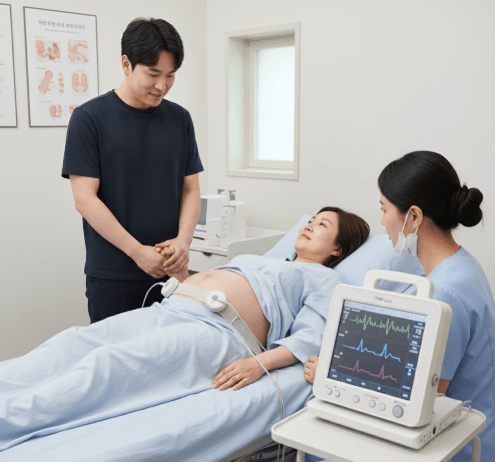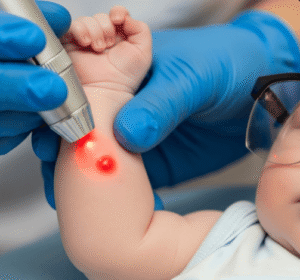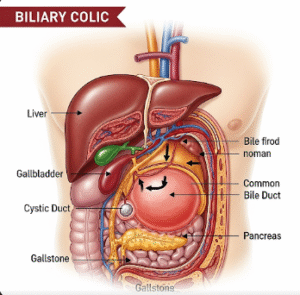What it is
A Non-stress Test (NST) is a prenatal procedure used to evaluate the baby’s health and well-being during pregnancy. It measures the baby’s heart rate, movements, and responses without causing stress to the fetus. The term “non-stress” means that no external pressure or medication is used—only natural fetal activity is observed.
👩⚕️ Core aspects of NST:
- 💓 Monitors fetal heart rate in relation to movements
- 🖥️ Uses external sensors placed on the mother’s abdomen
- 🕒 Usually performed in the third trimester (after 28 weeks)
- 🏥 Often recommended for high-risk pregnancies or if there are concerns about fetal growth
In Korea, NST is widely used as a standard fetal monitoring tool in both public hospitals and private clinics.
Why it’s done
NST helps doctors determine whether the baby is receiving enough oxygen and nutrients from the placenta.
🔹 Main reasons for NST include:
➡️ High-risk pregnancies – maternal conditions like diabetes, hypertension, thyroid disorders
➡️ Reduced fetal movement – when the mother feels fewer kicks than usual
➡️ Overdue pregnancy – monitoring after 40 weeks of gestation
➡️ Multiple pregnancies – ensuring each baby is receiving enough oxygen
➡️ Placental problems – checking for insufficiency or abnormalities
➡️ Routine monitoring – for mothers with complications like preeclampsia or IUGR (intrauterine growth restriction)
In Korea, doctors use NST as a preventive tool, ensuring early intervention if abnormalities are detected.
Alternatives
While NST is a primary test for fetal health, there are alternative or complementary methods.
🔸 Alternatives include:
- 🖥️ Biophysical Profile (BPP) – combines NST with ultrasound to check fetal breathing, movement, and amniotic fluid
- 🌡️ Contraction Stress Test (CST) – measures fetal response during induced contractions (less common now)
- 📊 Kick counts – mothers manually tracking fetal movements at home
- 🩺 Doppler ultrasound – measures blood flow through umbilical cord and placenta
⚠️ Note: These may complement NST but do not replace it, especially in high-risk pregnancies.
Preparation
NST is a non-invasive and simple test, but proper preparation ensures more accurate results.
✔️ Steps to prepare for an NST:
➡️ Eat a light meal or snack before the test (baby is more active after mother eats)
➡️ Stay hydrated, as dehydration can reduce fetal activity
➡️ Wear comfortable clothing so sensors can be easily placed
➡️ Keep a record of fetal movements to share with the doctor
➡️ Carry any previous reports if the test is being done at a new hospital
In Korea, many hospitals schedule NSTs after meals to increase the chances of recording active fetal movements.
How it’s done
NST is usually performed in a quiet hospital room where the mother can relax.
🩺 Step-by-step NST procedure:
- ✅ Mother lies in a reclined chair or bed
- ✅ Two sensors are placed on her abdomen:
- 💓 Fetal heart rate sensor
- ⏱️ Uterine contraction sensor
- ✅ The machine records fetal heart rate and uterine activity for 20–40 minutes
- ✅ If the baby is asleep, nurses may gently wake the baby with sound or vibration
- ✅ Results are classified as:
- Reactive (normal): Baby’s heart rate increases with movement
- Non-reactive: No sufficient increase; further tests may be needed
💡 Unique in Korea: Many hospitals provide real-time screen displays so parents can watch the baby’s heart rate patterns during the test. Some clinics even offer printed reports for keepsakes.
Recovery
Since NST is non-invasive and painless, there is no recovery period required. Mothers can return home immediately.
🟢 Post-test considerations:
- 🧘 Stay relaxed, as stress can affect fetal activity
- 💬 Discuss results with the doctor right after the test
- 📅 If results are non-reactive, additional tests may be scheduled (BPP, Doppler, or repeat NST)
- 🩺 Continue routine prenatal check-ups
- 🥗 Follow lifestyle recommendations to support fetal growth
In Korea, if NST shows concerns, doctors often recommend closer monitoring or temporary hospitalization until the baby’s condition stabilizes.
Treatment options in Korea
South Korea has state-of-the-art maternal care facilities, making NST widely available across clinics and hospitals.
🇰🇷 Options for NST in Korea include:
➡️ Public hospitals – affordable and covered under National Health Insurance Service
➡️ Private women’s clinics – shorter wait times, more personalized care
➡️ University hospitals – advanced monitoring, ideal for high-risk pregnancies
➡️ Maternity centers – combining NST with other prenatal services
🌟 Highlights of NST in Korea:
- ✅ Government support: Subsidized costs under maternity programs
- ✅ Advanced technology: Digital monitoring systems and automated result analysis
- ✅ Multilingual services: Many hospitals in Seoul and Busan cater to international patients
- ✅ High accuracy: Use of combined tests (NST + ultrasound) for reliable results
- ✅ Comprehensive care: Immediate referral to specialists if concerns are detected
✅ Final Note:
The Non-stress Test (NST) in Korea is an essential, safe, and effective tool to monitor fetal well-being, particularly in high-risk or overdue pregnancies. With advanced facilities, structured prenatal care, and government support, Korea ensures that mothers and babies receive top-quality monitoring and timely interventions when necessary.













